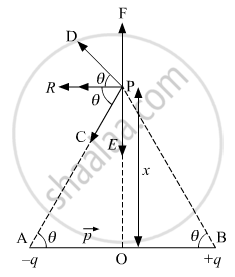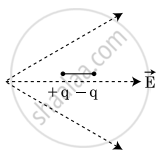Advertisements
Advertisements
Question
Find the resultant electric field due to an electric dipole of dipole moment, 2aq, (2a being the separation between the charges ±± q) at a point distant 'x' on its equator.
Solution
Consider a dipole consisting of two electric charges +q and −q between a small distance AB = 2a with centre O.
Now, let us find the electric field intensity at point P.

The magnitudes of the electric field at point P due to the two charges +q and −q are given by
`E_(+q) = q/(4πε_0) 1/(x^2+a^2) .....(1)`
and ` E_(-q) = q/(4πε_0) 1/(x^2+a^2) ...... (2)`
`∴ E_(+q) = E_(-q) `
The directions of E+q and E−q are as shown in the figure. The components normal to the dipole axis along PE and PF cancel away. The components along the dipole axis add up.
Therefore, the resultant electric field at point P is given as
`E = - (E_(+q) + E_(-q) cosΘ)` (The negative sign shows that the field is opposite to the dipole moment of the dipole.)
`E=(-2qa)/(4πε_0 (x^2+a^2)^(3/2)) ......(3)`
When point P lies at a large distance (x >> a) from the dipole, the above expression reduces to
`E = (-2qa)/(4πε_0 x^3 ) ....... (4)`
∴ `p =1 xx 2a`
∴ `E = (-p)/(4πε_0 x^3 )` (x >> a)
The direction of this electric field is along PR (or BA).
APPEARS IN
RELATED QUESTIONS
Derive the expression for the electric potential due to an electric dipole at a point on its axial line.
Define electric dipole moment. Is it a scalar or a vector? Derive the expression for the electric field of a dipole at a point on the equatorial plane of the dipole.
Two particles, carrying charges −q and +q and and of mass m each, are fixed at the ends of a light rod of length a to form a dipole. The rod is clamped at an end and is placed in a uniform electric field E with the axis of the dipole along the electric field. The rod is slightly tilted and then released. Neglecting gravity, find the time period of small oscillations.
An electric dipole consists of two opposite charges each 0.05 µC separated by 30 mm. The dipole is placed in an unifom1 external electric field of 106 NC-1. The maximum torque exerted by the field on the dipole is ______
Dimensions of mass in electric field and in electric dipole moment are respectively.
A dipole is placed in an electric field as shown. In which direction will it move?

Two charges –q each are fixed separated by distance 2d. A third charge q of mass m placed at the mid-point is displaced slightly by x(x << d) perpendicular to the line joining the two fixed charged as shown in figure. Show that q will perform simple harmonic oscillation of time period.
`T = [(8pi^3 ε_0 md^3)/q^2]^(1/2)`

A square surface of side l (m) in the plane of the paper. A uniform electric field E(V/m) also in the plane of the paper is limited only to the lower half of the square surface, the electric flux (in SI units) associated with the surface is ______.

Arrangement of an oxygen ion and two hydrogen ions in a water molecule is shown in figure below.
Calculate electric dipole moment of water molecule. Express your answer in terms of e (charge on hydrogen ion), l and θ.

